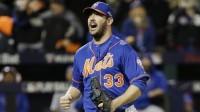The DH Doesn’t Drive Ratings

Even though Commissioner Rob Manfred said the NL will not have the DH anytime soon, he has opened up Pandora’s box with his previous comments that the NL could see the DH in 2017. With the Collective Bargaining Agreement expiring at the end of the year, the issue is still on that table. Accordingly, I believe it’s an issue that still needs to be addressed.
Now one of the key arguments anyone has in requesting the DH be implemented in the National League is because the move would increase offense. That is undoubtedly true. The corollary to this argument is that more offense will create higher ratings. It’s an axiom that is heard time and again, but is it true?
Before delving more in depth, there needs to be a clear understanding of baseball’s current business model. Baseball has become a regional sport. Part of this can be attributed to the rise of regional sports networks like SNY and YES. More likely, this is the result of every team having all 162 games televised. Given the choice, a vast majority of sports fans will choose to watch their team play than watch the National Game of the Week. For example, when ESPN has Wednesday Night Baseball, I’m watching the Mets.
The only real issue of what drives ratings is when the postseason begins. At that time, a fan has no other baseball viewing option. Whether you’re a die hard fan or a casual fan, you’re choices are limited.
For my determination of whether or not the DH helps with ratings, I selected the ALCS and the NLCS. With there being four division series shown at different times of the day, the issue of availability becomes murky. However, typically, MLB attempts to schedule the ALCS and the NLCS so there’s as little conflict as possible.
Last year, the NLCS between the Mets and Cubs was the most watched NLCS since 2010. The series averaged almost eight million viewers per game in what was a four game sweep. On the flip side, the ALCS was drawing record low numbers. There was a disparity of about three to seven million per game who watched each series. In 2014, the script was much different.
The 2014 NLCS featured the Giants and the Cardinals, two fairly historic and important National League teams. The Giants last won a World Series in 2012, and the Cardinals were in the World Series the previous year. This NLCS had terrible ratings. The Giants-Cardinals series drew about 4.5 million viewers per game. That was down two million from these teams NLCS two years earlier.
The 2014 ALCS between the Baltimore Orioles and Kansas City Royals drew terrific ratings. The series averaged 5.1 million viewers. It consistently outdrew the NLCS. It outdrew the NLCS despite having smaller media markets and less historic franchises. Was the difference the DH and the increased scoring that goes with it? No.
As we have seen, baseball will tend to attract more fans with better and more compelling series. It should be of no surprise that Mets-Cubs drew terrific ratings. These were two young teams with some terrific pitching going head-to-head. It also didn’t hurt these franchises had a history. It also doesn’t hurt that the Cubs haven’t won in forever.
So no, the DH and increased offense isn’t what is driving ratings. It’s the matchups. Plain and simple. If someone says the DH will hp increase offense and create better ratings, they are creating a narrative that simply does not exist. Sure, someone can argue that they don’t want to see a pitcher hit, but we also know it won’t stop them from watching a compelling game or series.
Overall, ratings is not a reason to bring the DH into the National League.